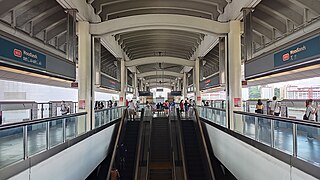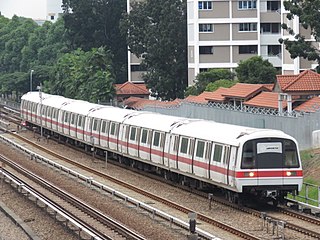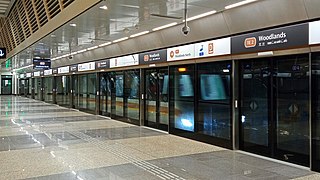
The North–South Line (NSL) is a high-capacity Mass Rapid Transit (MRT) line in Singapore, operated by SMRT Corporation. Coloured red on the Singapore rail map, the line is 45 kilometres (28 mi) long and serves 27 stations, 11 of which, between the Bishan and Marina South Pier stations, are underground. It runs from Jurong East station, located in Western Singapore, to Marina South Pier station in the Central Area, via Woodlands station in northern Singapore. The line operates for almost 20 hours a day, with headways of up to 1 to 2 minutes during peak hours and 5 to 8 minutes during off-peak hours. All the trains on the North–South Line run with a six-car formation.

The East–West Line (EWL) is a high-capacity Mass Rapid Transit (MRT) line operated by SMRT in Singapore, running from Pasir Ris station in the east to Tuas Link station in the west, with an additional branch between Changi Airport and Tanah Merah stations. It is the second Mass Rapid Transit line to be built in Singapore. Coloured green on the rail map, the line serves 35 stations, 8 of which are underground. At 57.2 kilometres (35.5 mi), the line is the longest on the MRT network.

Joo Koon MRT station is an above-ground Mass Rapid Transit (MRT) station along the East West Line in Pioneer planning area, Singapore.

The Kawasaki Heavy Industries & Nippon Sharyo C751B is the third generation electric multiple unit rolling stock in operation on the North–South and East–West lines of Singapore's Mass Rapid Transit (MRT) system since early 2000, manufactured by Kawasaki Heavy Industries & Nippon Sharyo (KNS) under Contract 751B. 21 trainsets of 6 cars each were purchased at S$231 million, and it is the first rolling stock to feature VVVF insulated-gate bipolar transistor traction control system. Kawasaki manufactured 66 cars and Nippon Sharyo manufactured 60 cars respectively with no comparable differences, having been built to agreed specifications. These trains are the third generation of rolling stock to be used on the two lines.

The Siemens C651 is the second generation electric multiple unit rolling stock in operation on the North–South and East–West lines of Singapore's Mass Rapid Transit (MRT) system, manufactured by Siemens Mobility (SIE) and SGP Verkehrstechnik under Contract 651. A total of 114 cars consisting of 19 train-sets were purchased in 1992 and introduced into service from 1995 onwards. These trains were built by Siemens in Austria.

The Kawasaki Heavy Industries C151 is the first generation electric multiple unit (EMU) rolling stock in operation on the North–South and East–West lines of Singapore's Mass Rapid Transit (MRT) system, manufactured by a consortium led by Kawasaki Heavy Industries (KHI) under Contract 151. They were first introduced in 1987 and are the oldest trains in operation on the network.

Bishan Depot or is a depot located on the Mass Rapid Transit in Bishan, Singapore. It was completed in 1986 by American architect Vikas M. Gore and the 12,000 square metres maintenance area at cost of S$300 million.

SMRT Trains Limited is a rail operator in Singapore and a wholly owned subsidiary of SMRT Corporation. After the privatisation of the MRT operations in 1995, it was originally named Singapore MRT Limited. On 31 December 2001, it was renamed SMRT Trains Limited, so as not to confuse with another MRT line - North East MRT Line that is under Singapore Bus Services and the bus operations merged from Trans-Island Bus Services. At the same time, Singapore Bus Services was renamed SBS Transit to be multi-modal. SMRT Trains currently manages most of the MRT services in Singapore except the North East Line and Downtown Line.

CRRC Qingdao Sifang Co., Ltd. is a Chinese rolling stock manufacturer based in Qingdao, Shandong province. Founded in 1900 during the German occupation, Qingdao Sifang is one of the oldest rolling stock manufacturers in China.

The Thomson–East Coast Line (TEL) is a high-capacity Mass Rapid Transit (MRT) line in Singapore. Coloured brown on the rail map, it is fully underground. When fully completed, the sixth line on the country's MRT network will serve 32 stations around 43 kilometres (27 mi) in length, becoming one of the world's longest driverless rapid transit lines. It runs along a combined north–south and east–west corridor, starting in the north at Woodlands town, passing through Upper Thomson and the towns of Ang Mo Kio and Bishan, heading south to the city-centre at Orchard Road and Marina Bay, subsequently heading eastwards along the eastern coast of the country through Kallang, Marine Parade and southern Bedok before ending at Upper East Coast.

The Bombardier MOVIA C951 is the first generation electric multiple unit rolling stock in operation on the Downtown Line of Singapore's Mass Rapid Transit (MRT) system. The contract was won by Bombardier Transportation and the rolling stock was built by Changchun Bombardier Railway Vehicles. Initially, the authorities had ordered 73 trains, although LTA had ordered an additional 15 trains and a final 4 more trains under C951A which makes a total of 92 trainsets were manufactured under C951.

The SMRT Active Route Map Information System is a rail travel information system developed in house by communications engineers from SMRT Corporation for its North South Line and East West Line (NSEWL) trains in Singapore. This system was officially announced on 7 November 2008 and was first installed on board a C151 trainset 053/054 for a 2-month trial. This was later extended to other trains from February 2009.

The Alstom Metropolis C830C is the second generation of communication-based train control (CBTC) electric multiple unit rolling stock in operation on the Circle line of Singapore's Mass Rapid Transit (MRT) system. 24 trainsets of 3 cars were manufactured by Shanghai Alstom Transport Co Ltd, with deliveries from end June 2014.

The Kawasaki Heavy Industries & CSR Qingdao Sifang C151B is the fifth generation electric multiple unit rolling stock in operation on the North–South and East–West lines of Singapore's Mass Rapid Transit (MRT) system, manufactured by Kawasaki Heavy Industries (KHI) & CRRC Qingdao Sifang under Contract 151B. 45 trains were purchased and all of them have been delivered to Singapore as of 12 April 2017. SMRT took delivery of the first 2 train cars on 21 May 2015. These trains increased frequency for the two MRT lines, North–South and East–West lines.

The Bombardier Innovia APM 100 C801 is the first generation of an automated people mover (APM) train built by Adtranz for use on the Bukit Panjang LRT (BPLRT).

The Kawasaki Heavy Industries & CRRC Qingdao Sifang C151C is the sixth generation electric multiple unit rolling stock in operation on the existing North–South (NSL) and East–West (EWL) lines of Singapore's Mass Rapid Transit (MRT) system, manufactured by a consortium of Kawasaki Heavy Industries (KHI) and CRRC Qingdao Sifang under Contract 151C.

The Kawasaki Heavy Industries & CRRC Qingdao Sifang T251 is the first generation electric multiple unit rolling stock in operation on the Thomson–East Coast line of Singapore's Mass Rapid Transit (MRT) system, manufactured by a consortium of Kawasaki Heavy Industries (KHI) and CRRC Qingdao Sifang under Contract T251.
FactWire was an investigative news agency headquartered in Kowloon, Hong Kong. Funded by crowdfunding via the crowdfunding platform FringeBacker in the first round of seed fund in 2015, FactWire was founded with the initial financial support of 3,300 Hong Kong residents.

The Joo Koon rail accident, sometimes referred to as the Joo Koon train collision, was a crash which happened on 15 November 2017, when a C151A train travelling at 16 kilometres per hour (9.9 mph) rear-ended a stationary C151A train at Joo Koon station on the East West MRT line, resulting in 38 injuries. The stationary train was in the process of being detrained due to a train fault. Both trains were operating under the recently installed Thales SelTrac CBTC signalling system at the time of incident, and the Minister of Transport Khaw Boon Wan expressed that he was "disturbed" by an initial finding that "critical safety software" was inadvertently removed from the stationary train, possibly due to a malfunctioning signalling circuit, which led to the crash. This incident is the second train collision in Singapore MRT's history, after the Clementi rail accident.




















